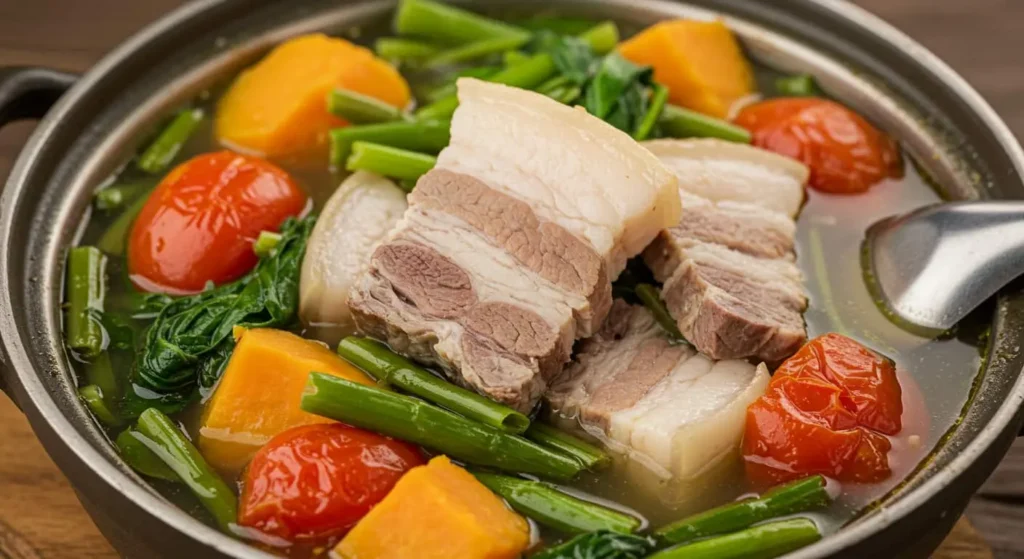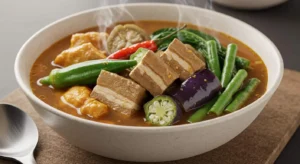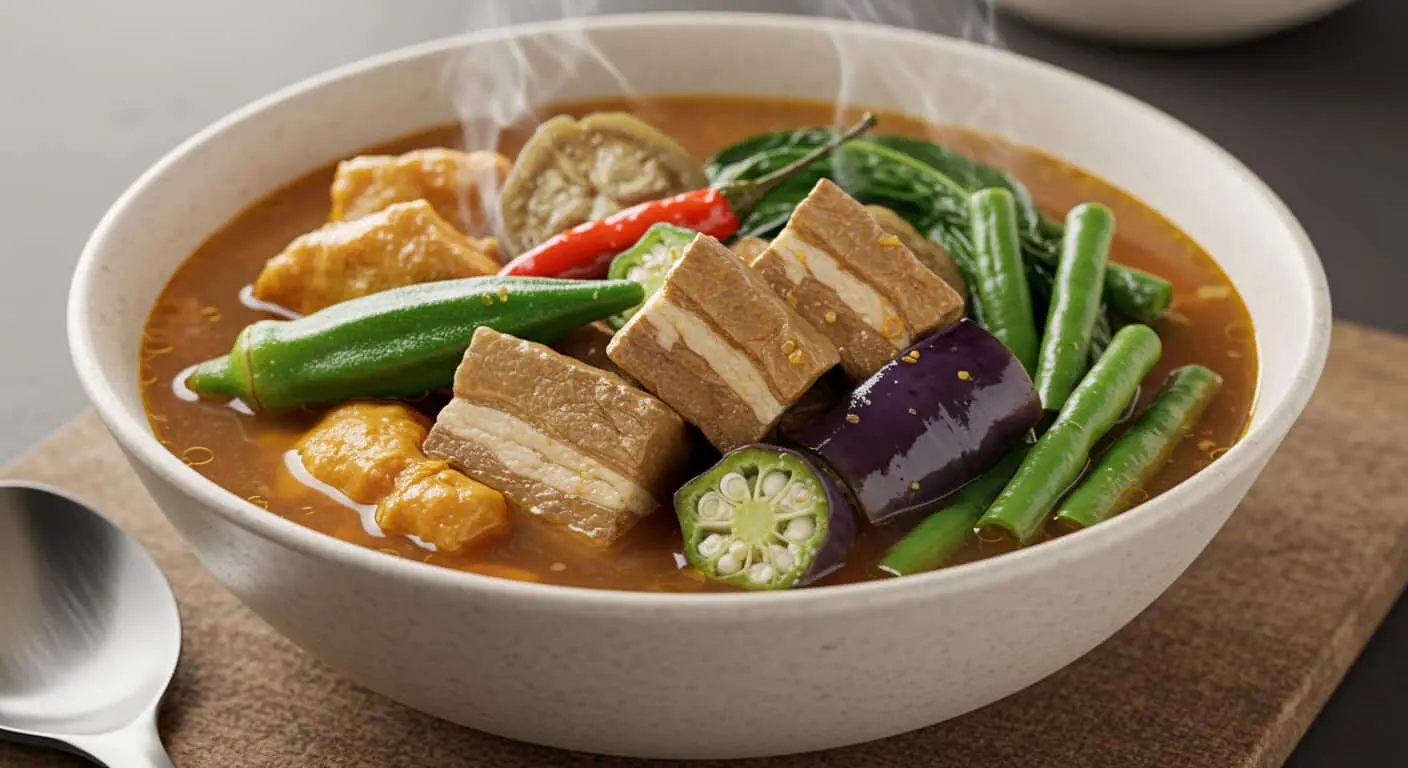Introduction: Why Sinigang Recipe is a Filipino Classic
Sinigang is more than just a dish in Filipino culture; it’s a symbol of warmth, family, and tradition. Whether served on a rainy day or at a family gathering, a sinigang recipe is a beloved comfort food that brings people together. At its core, sinigang is a sour soup, but its complexity lies in the delicate balance of savory, salty, and tangy flavors, making every spoonful irresistible.
What truly sets a sinigang recipe apart is the perfect marriage of its distinct sourness—usually from tamarind—with the rich, umami-packed broth that envelops tender proteins like fish, or shrimp. The vegetables, from okra to string beans, add texture and freshness, making sinigang a complete and satisfying meal. Each family may have their own version, but no matter how it’s made, sinigang is the ultimate comfort food. The savory aroma and mouthwatering taste of a sinigang recipe instantly evoke memories of home, reminding us that some dishes aren’t just about eating—they’re about experiencing love, connection, and tradition.
Whether you’re a first-timer or a sinigang connoisseur, crafting the perfect sinigang recipe is an experience that always leaves you craving more.
Table of Contents
Key Ingredients for an Irresistible Sinigang Recipe
Sinigang Ingredients:
Protein (Choose One)
- Fish (bangus or tilapia) (500 grams or about 1 lb) – For a lighter, fresher take on sinigang, fish is a wonderful option that pairs beautifully with the sour broth.
- Shrimp (500 grams or about 1 lb) – A popular protein choice, shrimp adds a subtle sweetness to the dish, which contrasts well with the sourness of the broth.
- Beef short ribs (500 grams or about 1 lb) – For a rich, hearty variation, beef offers a deep flavor that stands out in sinigang.
Souring Agent:
- Tamarind (1/2 cup tamarind paste or 1-2 cups fresh tamarind pods) – The quintessential souring agent in a sinigang recipe, tamarind gives the broth its signature tang. You can use fresh tamarind pods or tamarind paste if you prefer convenience.
- Alternative souring agents (optional): You can swap or combine tamarind with green mango (1 small mango, sliced), calamansi (4-5 fruits), or guava (2-3 medium fruits) for a unique twist on the traditional flavor.
Vegetables:
- Okra (1 cup, sliced) – Adds a mild, slightly slippery texture that enhances the broth.
- Eggplant (1 medium, sliced) – Absorbs the flavors of the broth and adds a creamy texture.
- String beans (sitaw) (1 cup, cut into 2-inch pieces) – Provides a fresh, slightly crunchy bite that contrasts the tender meat and soft vegetables.
- Kangkong (water spinach) (2 cups) – This leafy green adds a fresh, delicate flavor to the broth, making it a sinigang staple.
- Bok choy (optional, 1 bunch) – Adds a light, crisp texture and mild flavor that rounds out the vegetable mix.
Seasoning & Flavoring:
- Fish sauce (2 tablespoons) – Essential for deepening the savory notes of the broth.
- Bagoong (shrimp paste) (optional, 1 teaspoon) – If you like a more umami kick, a dash of bagoong can enhance the richness of the broth.
- Salt (to taste) – Essential to balance the flavors and bring everything together.
- Siling labuyo (chili pepper) (optional, 1-2 peppers) – For those who enjoy a spicy kick, siling labuyo adds a heat that complements the sourness of the broth.
Crafting the Perfect Sinigang Broth: Step-by-Step Guide
The sinigang recipe is only as good as its broth, and crafting the perfect broth is an art that requires both patience and attention to detail. Here’s a detailed guide on how to craft the perfect sinigang broth, whether you’re making it from scratch or using a mix.
Learn more about the history and traditional techniques of Filipino cooking on The Filipino Kitchen to deepen your culinary skills.

Making the Broth from Scratch
The soul of any sinigang recipe lies in the broth, and when made from scratch, it can be nothing short of spectacular. The process begins with choosing your souring agent, and the traditional choice is tamarind. Fresh tamarind pods offer a wonderful, authentic flavor, but tamarind paste is a convenient and equally effective option.
To make the broth:
- Prepare the Base: Begin by simmering your protein (fish, or shrimp) in about 6 cups of water. For a more intense flavor, sear your meat lightly before adding it to the pot.
- Add the Tamarind: Once the meat is starting to soften, add tamarind (either fresh or paste). If using fresh tamarind, let the pods cook for 15-20 minutes until they soften, then mash them in the pot to release their sour flavor. If using paste, stir it in and let it dissolve into the broth.
- Build the Flavor: To enhance the broth’s richness, add fish sauce, salt, or a bit of miso paste for an umami kick. Miso, in particular, adds a savory depth that complements the sourness of the tamarind. Always taste as you go and adjust these seasonings to create a well-rounded, flavorful broth.
- Vegetables and Final Simmer: After the tamarind has infused the broth, add your vegetables. Okra, eggplant, string beans, and kangkong are common choices. Let everything simmer for another 10-15 minutes, allowing the vegetables to tenderize while preserving their vibrant color and texture.
Tips for achieving the right sinigang recipe broth:
- For a richer texture, you can add a small amount of miso or even a spoonful of fermented shrimp paste (bagoong) if you prefer a deeper umami flavor.
- The key to the perfect broth is time—let it simmer gently, never boiling too aggressively, to avoid overcooking the vegetables and losing the delicate flavors.
Using Store-Bought Souring Mixes vs. Homemade
For those who are short on time, instant sinigang mixes can be a convenient alternative. These pre-packaged mixes offer a quick way to recreate a sinigang recipe, especially when you’re craving the dish but don’t have access to fresh tamarind. While they can save time and effort, it’s essential to understand the pros and cons.
Pros:
- Convenience: Instant mixes are fast and easy to use—just add them to your boiling water and protein, and you’re good to go.
- Consistency: The flavor profile is consistent, which is especially helpful for beginners who might struggle with balancing sourness or saltiness.
Cons:
- Lack of Depth: Pre-packaged mixes don’t have the complexity and freshness that comes with homemade sinigang recipe broths.
- Higher Sodium: Many instant mixes contain high levels of sodium, which could make your broth saltier than intended.
When to Use Packaged Versions:
- If you’re in a hurry or craving sinigang but don’t have time to cook from scratch, an instant mix can certainly do the job. It’s also great for beginners who want a reliable and simple way to start learning how to make sinigang.
When to Opt for Homemade Broth:
- When you want a more authentic sinigang recipe, or when you have the time to experiment with different flavors. Making your broth from scratch allows you to control the level of sourness, saltiness, and richness, ensuring a completely personalized dish.
How to Adjust the Sourness and Saltiness
Balancing the sourness and saltiness of your sinigang recipe is an essential skill. Too much sourness and your broth will feel overwhelming; too little and it may taste flat. The same goes for saltiness—finding the right balance is key.
Adjusting Sourness:
- Taste as You Go: Start with your chosen souring agent (tamarind or an alternative) and taste the broth throughout the cooking process. If the broth is too tangy, add a bit more water to dilute it. If it’s not tangy enough, add a bit more tamarind or substitute with green mango, calamansi, or even a splash of vinegar.
- Add Slowly: It’s always best to add souring agents little by little, especially if you’re using fresh ingredients like tamarind. This allows you to gauge the level of sourness and prevents the broth from becoming too sharp.
Adjusting Saltiness:
- Fish Sauce and Salt: The two primary ingredients used for seasoning are fish sauce and salt. Start with 2 tablespoons of fish sauce and 1 teaspoon of salt, then taste. If it needs more salt, add it gradually to avoid over-seasoning. Fish sauce has a salty yet umami flavor that can bring your sinigang recipe to life, but it can be overpowering if added too quickly.
- Adding Bagoong (Shrimp Paste): If you want to enhance the depth of the broth, consider adding a small amount of bagoong. This fermented shrimp paste can lend a rich, umami flavor that balances the sourness, but use it sparingly as it can be potent.
Final Tasting: Once all the ingredients are added and the broth has simmered, taste the sinigang again to ensure it’s balanced. The sourness should hit your palate first, followed by a savory richness and a hint of saltiness. If any of these flavors are too strong or too weak, adjust accordingly.
Perfecting the Proteins: Fish, or Shrimp?
One of the most distinctive aspects of a sinigang recipe is the choice of protein, and each option brings its own unique flavor and texture to the dish. Whether you prefer the delicate flavors of fish, or the sweet juiciness of shrimp, getting the protein just right is crucial for crafting an unforgettable sinigang. Here’s how to perfect your proteins, no matter which one you choose.
Fish and Seafood Variations
Many Filipino families enjoy seafood variations, which offer a lighter yet equally delicious alternative. Fish, especially bangus (milkfish) and tilapia, can add a delicate and slightly sweet flavor to the soup. Shrimp is another popular option that infuses the broth with a subtle sweetness and a light, tender texture.
- Bangus (Milkfish): Known for its rich, slightly fatty flavor, bangus is perfect for sinigang because its taste pairs beautifully with the tangy broth. It’s important to clean and gut the fish properly to avoid any unpleasant flavors, and cooking it gently ensures the flesh stays tender and doesn’t fall apart in the soup.
- Tilapia: This white fish is mild and flaky, absorbing the broth’s flavors wonderfully. It’s quick to cook and won’t overpower the taste of the sinigang, making it a perfect option for a lighter, yet flavorful, meal.
- Shrimp: If you’re opting for shrimp, be sure to cook it last to preserve its tender texture. Overcooking shrimp can result in a rubbery texture, which is far from ideal in a sinigang recipe. Shrimp also brings an extra layer of sweetness that complements the sour broth beautifully.
Tips for Cooking Proteins to Perfection
No matter which protein you choose for your sinigang recipe, it’s essential to cook it properly to ensure it stays tender and flavorful. Here are some helpful tips:
- Simmer, Don’t Boil: For seafood, avoid boiling the meat at high heat. Boiling can toughen the protein and make it less enjoyable. Instead, simmer the meat gently to allow it to tenderize and absorb the flavors of the broth.
- Timing Is Key: Fish and shrimp cook much more quickly—usually in just 10-15 minutes. Add them towards the end of the cooking process to keep them tender and juicy.
- Avoid Overcooking: Overcooking is the enemy of a perfect sinigang recipe. Fish and shrimp should maintain their integrity and not become mushy or dry. Always test your protein as it cooks and pull it off the heat as soon as it’s done.
- Flavor Absorption: The longer your protein simmers in the sinigang broth, the more it will absorb the flavors. However, keep in mind that some proteins, like shrimp, may absorb too much broth if left too long. For the best result, ensure your proteins are cooked just long enough to absorb the tangy, savory flavors of the broth without losing their texture.
How to Customize Your Sinigang Recipe: Variations and Tips
The beauty of sinigang lies in its versatility. While the traditional sinigang recipe is beloved for its simple yet rich flavors, there are endless ways to customize and elevate the dish. Whether you want to add a touch of sweetness, experiment with fusion flavors, or make the broth even more robust, these creative variations and tips will help you craft a sinigang recipe that’s uniquely yours.

Creative Additions to Enhance Your Sinigang
A key aspect of any great sinigang recipe is the balance of flavors. Adding ingredients that bring a different dimension to the dish can make a huge difference, whether you want a sweet twist or extra depth.
- Sweet Potato (Kamote) or Plantains: For a delightful contrast to the tangy broth, try adding sweet potato or plantains. These ingredients bring a subtle sweetness that complements the sourness of the tamarind. Sweet potato softens beautifully in the broth, adding a comforting texture, while plantains offer a slightly savory sweetness that deepens the overall flavor profile of your sinigang.
- Leafy Greens: While kangkong (water spinach) is a traditional addition, feel free to explore other leafy greens like malunggay (moringa) or mustard greens. Malunggay brings a slightly earthy, slightly bitter flavor that balances the sour broth perfectly, while mustard greens add a peppery note. Experimenting with these greens can bring new layers of flavor and texture to your sinigang recipe.
Sinigang with a Twist: Fusion Variations
While the classic sinigang recipe is tried and true, there are several exciting variations you can try to give the dish a new twist, combining Filipino flavors with other culinary influences.
- Sinigang sa Miso: This variation incorporates miso paste into the broth, creating a sinigang that’s both tangy and savory. Miso adds an umami richness, making the broth more complex. The earthy flavor of miso enhances the sourness of the tamarind, giving the sinigang a fuller, more robust taste. This version is especially delicious when paired with fish or shrimp.
- Sinigang sa Bayabas (Guava): Another exciting fusion twist is sinigang sa bayabas, which uses guava as the souring agent instead of tamarind. Guava gives the sinigang recipe a unique fruity flavor that’s both sweet and sour, creating a more tropical version of the dish. The mild sweetness of guava pairs wonderfully with fish, and the slight tanginess balances the richness of the protein.
These variations show how flexible the sinigang recipe can be, offering endless possibilities to suit different tastes and preferences.
Tips for Making Sinigang More Flavorful
To truly elevate your sinigang recipe, there are a few tips and techniques you can apply to deepen the flavors and create a more satisfying dish.
- Use a Slow Cooker or Pressure Cooker: For a more intense, flavorful broth, consider using a slow cooker or pressure cooker. Slow cooking allows the flavors to meld together gradually, infusing the broth with richness and depth. A pressure cooker speeds up the process while still extracting maximum flavor from the ingredients. Both methods are ideal for creating a more complex and well-rounded sinigang recipe.
- Simmer Longer for a Complex Broth: If you have the time, allow your broth to simmer for an extended period. The longer the broth simmers, the more the flavors develop and intensify. This slow simmering process helps release all the umami from the proteins, vegetables, and any seasonings you add. Just be sure not to overcook your vegetables or proteins, as this can affect their texture.
Conclusion: Mastering Your Irresistible Sinigang Recipe
Crafting the perfect sinigang recipe is all about balance. By carefully selecting the right souring agent, whether it’s tamarind, miso, or even guava, and blending it with the right proteins— fish, or shrimp—you create a broth that’s rich, savory, and undeniably comforting. The key to an irresistible sinigang recipe lies in finding the perfect harmony between sourness, savory depth, and a hint of spice.
We’d love to hear about your sinigang adventures! Share your creations, tips, and favorite variations in the comments. Your version of this Filipino classic could inspire someone else to create their own irresistible sinigang recipe. So go ahead, embrace the flavors, and master the art of sinigang—one comforting bowl at a time!
Sinigang Recipe

Savory and sour, this traditional Filipino sinigang recipe features a tamarind broth and your choice of shrimp, fish, or beef. To Thai it up, you can also add vegetables such as okra, eggplant, string beans, and kangkong. Learn how to achieve the perfect balance of the sour and savory flavors of this comforting dish!
Type: Main Course
Cuisine: Filipino
Keywords: Sinigang Recipe
Recipe Yield: 4–6
Calories: 250–400 CALORIES
Preparation Time: PT20M
Cooking Time: PT40M
Total Time: PT1H
Recipe Ingredients:
- Fish (bangus or tilapia)
- Tamarind
- Beef short ribs
- Okra
- Eggplant
- String beans
- Kangkong (water spinach)
- Bok choy
- Fish sauce
- Bagoong (shrimp paste)
- Salt
- Siling labuyo (chili pepper)

